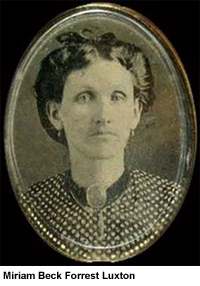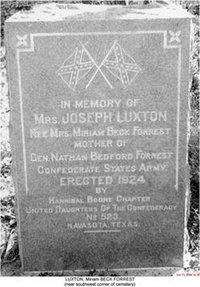
The President’s Message:
Good News! We will be
having a Round Table meeting on Wednesday, September 13th at 7:00PM at the
Lake Clarke Town Hall. I
look forward to seeing everyone there.
Better News!
Patrick Falci, actor and historian, will be out March, 2024
speaker. His topic will be
the
Four Interments of A.P. Hill or Your Can’t Keep a Good Man Down.
I know that it will be a very interesting meeting.
We will have some
books for sale at the meeting so bring your spare change.
Gerridine.
September 13, 2023 Program:
The program in September will be
Interesting Personalities You
May Not Know about in the Civil War presented by Gerridine LaRovere and
Janell Bloodworth.
Story by Gerridine:
The
Formidable Miriam Beck Forrest Luxton
 Gerridine has produced this
small essay about Miriam Beck Forrest Luxton. Some people have a
commanding presence and a peculiarity that eludes prediction. Miriam
was one of them. She was born in 1802 into a family of strict
Presbyterians of Scottish ancestry in South Carolina. In 1810, they
moved to Caney Springs, Tennessee and settled on the Duck River. Gerridine has produced this
small essay about Miriam Beck Forrest Luxton. Some people have a
commanding presence and a peculiarity that eludes prediction. Miriam
was one of them. She was born in 1802 into a family of strict
Presbyterians of Scottish ancestry in South Carolina. In 1810, they
moved to Caney Springs, Tennessee and settled on the Duck River.
At the age of eighteen Miriam
married William Forrest who was a blacksmith by trade. On July 13, 1821
she gave birth to a set of twins — a son, Nathan and a daughter,
Frances, called Fanny by the family. They would have a total of eleven
children during their marriage. In 1834, the Forrest family moved from
Tennessee to Tippah County in northern Mississippi that had been Indian
Territory. When they first settled in Mississippi , the nearest
neighbor was ten miles away via a very narrow path.
William Forrest died in
1837. By this time Miriam also lost two sons and three daughters to
“pestilent fevers.” With her son, Nathan Bedford, and his five
surviving brothers, the family cleared and drained swamp land for
farming. Miriam remarried in 1843 to Joseph M. Luxton. She gave birth
to three more sons and one daughter. By the beginning of the Civil War,
Joseph Luxton died, and Miriam owned and operated a successful
plantation near Memphis. During the War, family history claims that all
but one son fought for the Confederacy. None of her other sons rose to
the prominence of Nathan Bedford Forrest.
What kind of person was Miriam? She
was almost six feet tall with a large muscular frame and weighed
approximately 180 pounds. Her eyes were a blue-grey color and she had
dark brown hair. People said that her expression was gentle and
kind. However, she possessed a no-nonsense strong-willed personality
with courage and dogged determination. She was extremely straight
forward and finished any task that she started.
Some said that she was set in
her ways which were always the right “way.” Miriam ruled her household
with an iron fist. Although she was strict and severe with her
children, it was said that she loved them dearly.
Miriam rose before daylight in
order to get everything ready for work by the time the sun came up. On
weekdays everyone on the farm had breakfast together and often by
candlelight in order to start doing chores early. Miriam and her
sister, Fannie Beck, spun yarn and cotton thread. They wove the cloth
on looms, made clothes and knitted socks. They performed all the other
tasks of a home maker. The only supplies that were purchased were
coffee, sugar, and tea.
One day Miriam and Fannie
visited a distant neighbor. When they left in the late afternoon, their
friend gave the sisters a basket containing several young
chickens. Within a mile of their home in near darkness, they
encountered a panther. It had picked up the scent of the chickens and
began chasing them. The frightened horses broke into a run over a very
narrow trail. Fannie begged Miriam to throw the chickens to the
panther, but she refused to do it. She said that she was not going let
that varmint have her chickens!
When they reached the creek
near their cabin, they had to slow to a walk in order to cross
safely. The panther sprung and clawed Miriam on the side of her neck,
ripping the clothes off her back, and leaving severe wounds. The
panther also clawed the horse who threw off the panther. Throughout the
ordeal Miriam held onto the basket of poultry. Nathan immediately left
with his dogs and tracked the panther for miles. The dogs cornered the
animal in a tree. At daybreak, Nathan shot it. He cut off the ears and
scalp and presented them to his mother.
In 1861, Miriam was living on
the plantation near Memphis. Her eighteen year old son, Joseph Luxton,
joined the Confederate army. On a Friday afternoon he went to visit
Miriam dressed in his spiffy new Confederate uniform. His mother told
him that he would be the one to take her corn to the mill for grinding
the next day. Early Saturday morning he absolutely refused to take the
corn to the mill. In a flash Miriam cut peach tree switches and
thrashed him thoroughly. A day he remembered probably for the rest of
his life. He did go to the mill. Miriam said, ”Soldier or no soldier,
my children will mind me as long as I live.” She was a firm believer in
the proverb that if the rod is spared, the child will be spoiled.
Ira and Eliza Camp were close
friends of the family. They left Mississippi in 1846 and settled in
Navasota, Grimes County, Texas. The Camp’s built a stone house and an
inn where Sam Houston was often a guest. In 1863, General Forrest had
his mother and her two younger children escorted from Tennessee to the
safety of Ira and Eliza Camp Inn. Miriam always considered the Camp
family’s inn a safe haven for herself. After the War, Miriam and her
children moved to Texas.
In 1867, James Madison Luxton,
a son from her second marriage, was wanted for an undescribed crime
committed in Tennessee. He found his way to Grimes County and became a
deputy sheriff. James fell seriously in the fall of 1867. Miriam
rushed by carriage to his aid. As she stepped off the carriage in
Navasota, a nail penetrated her foot. She subsequently suffered blood
poisoning and died at Camp Inn on November 15, 1867. She was buried in
the Ira Camp family cemetery in Navasota. In1924, the Hannibal Boone
Chapter of the United Daughters of the Confederacy placed Marker 523 on
her grave in honor of her son Nathan Bedford Forrest, a controversial
figure.
Her son James survived and eventually raised a family in Uvalde County,
Texas. Miriam rose before
daylight
Last changed: 08/31/23 |

